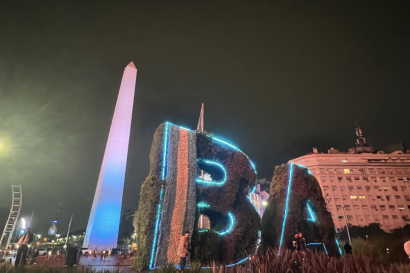Cuando llegues al Microcentro de Buenos Aires, hay algunas cosas en que inmediatamente fijas: el montón de rascacielos que parecen hecho de espejos, el vestuario muy lindo de toda la gente y el hecho de que cada cara que ves es blanca.
Antes de venir a Buenos Aires, sabía que Buenos Aires tenía una población muy grande de descendientes de italianos, alemanes o europeos en general. Ya sabía eso pero no pensaba que la mayoría de la población de una ciudad latinoamericana fuera blanca. Con mi propia piel blanco y una mezcla de características europeas y latinas me integro a Buenos Aires mejor que esperé.
Entonces, después de darme cuenta de esta ausencia, me preguntaba, ¿dónde están los que parecen más típicamente latinos? ¿Y cada las otras razas? Mi primer viaje en el tren resolvió esta pregunta. Era azaroso y luego aprendí que cada viaje en el tren o subte sería lo mismo.
Un hombre entró en el vagón y vino a cada pasajero para ofrecer sus productos que estaba vendiendo. Pensaba que fue una situación rara, pero no pensé más en la interacción. Pasaron algunos minutos. Otra persona entró, con una caja de chocolates, también intentando de venderlos a todos en el vagón. Casi nadie lo reconoció. Todos solían a estas interrupciones en sus viajes al trabajo. Pienso que en mi primer viaje había cuatro vendedores en el viaje de 15 minutos, el último era un hombre sin brazo en una silla de ruedas sólo pidiendo dinero para sus facturas médicas. Y este viaje, mi tercer día, fue la primera vez en que vi a tantos “indios” en Buenos Aires. Otros días por supuesto vi a más personas de varias etnicidades por las semanas acá, pero cuando sólo viajaba a los barrios ricos en los tres primeros días, podía ver la separación distinta.
Aprendí que hay un gran problema con colorismo y racismo en Buenos Aires y toda Argentina y este asunto conecta a las clases socio-económicas. Casi nunca veo a indios ni ninguna otra raza menos blancos en áreas más afluentes. Buenos Aires clama a tener mucha diversidad pero la verdad es que lo que tiene es segregación que es parecida a la opresión sistémica de personas negras y morenas en los Estados Unidos. Tengo que investigar más pero se puede ver la segregación no sólo por los barrios y vida sino también en los medios de comunicación, como en películas en programas. Ni siquiera intentan a tener un reparto diverso; vi una película el otro día en que cada persona, incluyendo extras, era blanca.
Sabía que el colorismo existía en Latinoamérica y Argentina, pero no creía que existiera a este nivel.
(The hidden citizen)
When you get to the Microcentro of Buenos Aires, there are some things that you immediately notice: tons of skyscrapers that look thousands of mirrors, everyone’s nice clothes, and also the fact that every face you see is white.
Before coming to Buenos Aires, I knew that Buenos Aires had a very large population of descendants of Italians, Germans or Europeans immigrants, but I did not think that the majority of the population of a Latin American city was white. With my own white skin and a mix of European and Latina characteristics, I blended into Buenos Aires better than I expected.
Then, after realizing this absence, I wondered, where are the people who look more conventionally Latinx? And every other race? My first trip on the train solved this question. It was quite eventful and then I learned that every trip on the train or subway would be the same.
A man got into the train car and came to each passenger to offer the products he was selling, markers I think. I thought it was a rare situation, but I didn’t dwell on the interaction. A few minutes passed. Another person came in, with a box of chocolates, also trying to sell them all in the car. Almost no one acknowledged him; I guess they were all used to these interruptions in their morning commutes. I think that on my first trip there were four vendors during the 15-minute trip; the last was a man missing an arm and riding in a wheelchair just asking for money for his medical bills. And this trip, my third day, was the first time I saw so many "indios" in Buenos Aires. Other days of course I saw more people of various ethnicities in the weeks after, but when I was only traveling to rich neighborhoods in the first three days, I could see the distinct separation between the whites and non-whites.
I learned that there is a big problem with colorism and racism in Buenos Aires and all of Argentina and this affair connects socio-economic classes. I hardly ever see Indians or any other less white race in more affluent areas. Buenos Aires claims to have a lot of diversity but the truth is that what it has is segregation that is similar to the systemic oppression of black and brown people in the United States. I have to investigate more but you can see segregation not only by neighborhoods and life but also in the media, as in movies in programs. They do not even try to have a different cast; I saw a movie the other day when every person, including extras, was white.
I knew that colorism existed in Latin America and Argentina, but I didn’t expect it exist at this level.
Amanda Landaverde
<p>Amanda Landaverde is a 20 year-old Spanish and Psychology student at Gustavus Adolphus College who aims for a career in neuroscience studying generational trauma. In her free time, Amanda likes to creatively illuminate and counteract social injustice through art, writing, and performance with her social justice theatre troupe on campus.</p>






